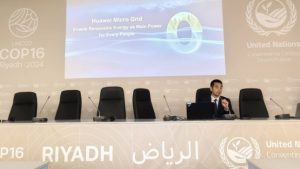[International Energy Network Live Report] Mr. Yuan Hu, Minister of Digital Energy Solutions Department of Saudi Arabia, Huawei Digital Energy, proposed microgrid technology combining renewable energy to increase power supply in a side event titled ” Solar empowers land and People from scarcity to prosperity Integrated Solutions for water, food and ecosystems” of COP16 was held at the China Pavilion in Riyadh, Saudi Arabia on December 9.
The side event was hosted by the Energy Transition and Social Development Research Center of the School of Social Sciences of Tsinghua University and co-hosted by the Hangzhou Solar Photovoltaic Industry Association. The conference aims to provide the most convenient living and production energy for people in desert areas by showcasing China’s off-grid solar products to the conference, help achieve the SDG goals, and contribute Chinese wisdom to countries and people in remote areas around the world.
During the conference, Yuan Hu, Director of Huawei’s Saudi Digital Energy Solutions Department, pointed out in his speech: At present, there are still 775 million people living without electricity in the world, and the losses caused by power outages are as high as US$185 billion each year. In order to solve this problem, Huawei proposed microgrid technology, combining renewable energy such as solar energy and wind energy to increase power supply.

Mr. Yuan Hu, Minister of Digital Energy Solutions Department of Saudi Arabia, Huawei Digital Energy
In order to let the participants have a deeper understanding of Huawei’s microgrid technology, Yuan Hu introduced Huawei’s project cases in Saudi Arabia and Nigeria.
Red Sea New City is an important part of Saudi Arabia’s “Vision 2030”, which aims to demonstrate Saudi Arabia’s determination and actions in promoting a green economy by building a city that relies entirely on renewable energy. The project covers an area of 28,000 square kilometers, equivalent to half the land area of Belgium, and plans to build a world-class tourist destination, receiving millions of tourists each year.
As a leading global ICT solution provider, Huawei has continued to make efforts in the energy field in recent years, especially in digital transformation and smart grid construction.
According to Yuan Hu, the Red Sea New City Photovoltaic Storage Microgrid Power Station is the world’s first city-level project that relies entirely on photovoltaic power generation and energy storage technology to maintain operations. The total installed capacity of the power station reaches 400MW, equipped with a 1.3GWh battery energy storage system, which can effectively cope with demand fluctuations during peak hours of urban electricity consumption.
The power station has cumulatively delivered more than 1 billion kWh of clean electricity since it was put into use in September 2023, showing excellent performance and reliability.
Yuan Hu said that Huawei Digital Energy’s commercial and industrial intelligent photovoltaic (FusionSolar) green electricity solution emphasizes active safety and advanced integration, aiming to transform the integration of “photovoltaic + energy storage + charging piles”. Through intelligent management, this technology optimizes the efficiency of new energy power generation, reduces operating costs, and makes new energy gradually become the main energy source, providing strong support for the green transformation and sustainable development of the energy industry.






